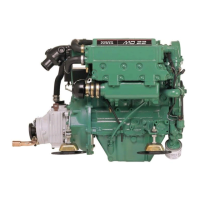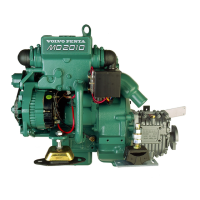10
5. Pressure switch – Alarm test/Acknow-
ledge
No alarm: Alarm test (all warning lights on – not
flashing– and the siren sounding).
Alarm: Acknowledgement of alarm.*
*The siren stops sounding, but the warning light continues to
flash until the fault has been rectified. If a new alarm condition
arises, the siren will sound again and the next warning light will
also start to flash, and so on.
6. Pressure switch
−−
−−
−instrument lighting
7. Key switch
The key switch has five positions, including 0:
Pos.0 = Key can be inserted and removed.
S = The mechanical restart block disengages.
The key springs back automatically to 0.
I = Running position. Key springs automatically
back to running position after starting.
II = “Glow” position.
III = Start position (starter motor comes on). Let
the key go as soon as the engine has started.
See also the starting instructions on page 13.
A disc is provided with the keys which gives the key
code. This code must be stated when ordering new
keys. Do not keep the number disc on the boat. Do
not allow unauthorised persons access to the code.
8.Temperature gauge
The temperature gauge should normally show approx.
75-95
o
C (167-203
o
F) during normal operation. The
acoustic alarm comes on when the coolant is too hot.
If an alarm is emitted, reduce the speed to idling
(in neutral) until the temperature decreases.
Investigate the cause (e.g. restricted water supply to
the engine). Stop the engine if the temperature
does not decrease.
9. Oil pressure gauge
The oil pressure gauge should normally show approx.
150-500 kPa (1.5-5 kp/cm
2
= 21-71 lbf/in
2
) during
operation. It is normal for the gauge to show a lower
value when the engine is idling.
The acoustic alarm comes on when the oil pressure is
too low. When the alarm sounds, stop the engine
immediately and locate the cause.

